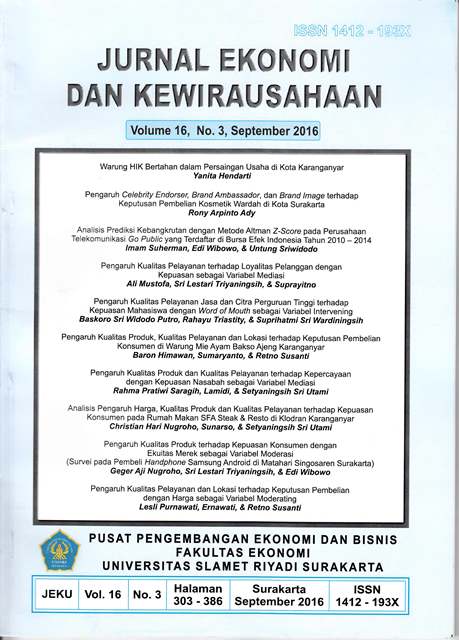WARUNG HIK BERTAHAN DALAM PERSAINGAN USAHA DI KOTA KARANGANYAR
Abstract
This study aims to determine how the efforts of merchant stalls HIK (traders immigrants from outside the town of Karanganyar) in order to survive in the face of competition in the town of Karanganyar. Improvement of street vendors in the city of Karanganyar significantly from year to year. The increase was supported also by government policies in terms of the provision of land or a trade. Street vendors located in the town of Karanganyar include small food vendors, food stalls, coffee shops, small kiosks and others. One type of vendors who shows the development (in terms of quantity) in the town of Karanganyar is Warung HIK. is a merchant stalls HIK are street vendors (seller men) who sell food and drinks, such as coffee, tea, ginger, some snacks and a lunch pack. They trade on pavements or in front of the shopping center, special for the evening, after the store closed. Based on the results and discussion, it can be concluded that: Traders stall HIK in the town of Karanganyar been able to develop well and able to withstand competition, the ability to grow and survive the competition, in addition driven factors skills and high morale, also driven by involvement of social capital among traders, HIK stalls, stalls in the town of Karanganyar HIK can be classified into three categories, namely merchant stalls HIK independent, semi-independent and non-independent and most buyers find it convenient to stop by to linger in HIK stalls.
Keywords: HIK stalls, street vendors, competition
Downloads
Published
Issue
Section
License
Authors who publish this journal agree to the following terms:
- Authors retain copyright and grant the journal right of first publication with the work simultaneously licensed under a Creative Commons Attribution License that allows others to share the work with an acknowledgement of the work's authorship and initial publication in this journal.
- Authors can separately make additional contractual arrangements for non-exclusive distribution published by the journal (e.g., publish it in a book), with an acknowledgement of its initial publication in this journal.
- Authors are allowed and encouraged to send their work via online (e.g., in the institutional repositories or their website) after published by the journal.









